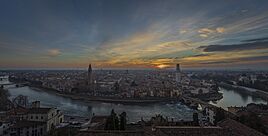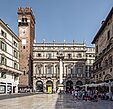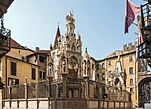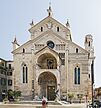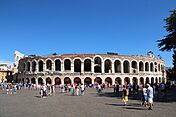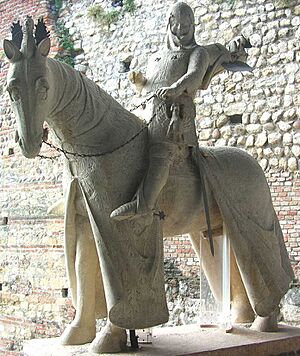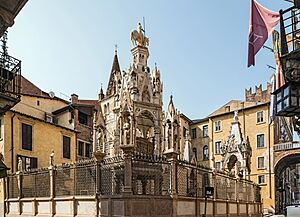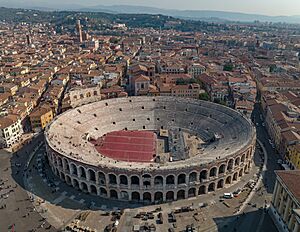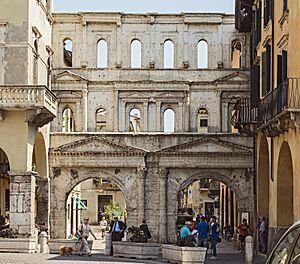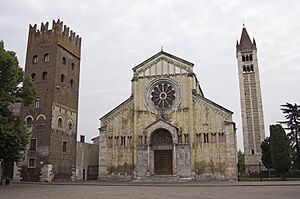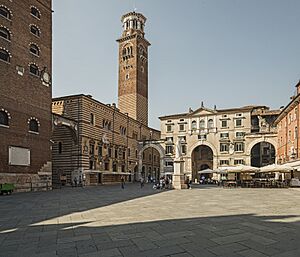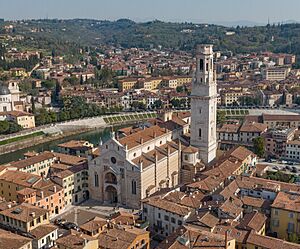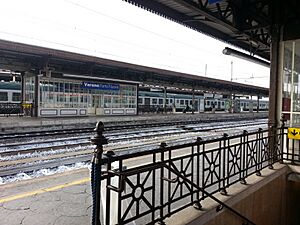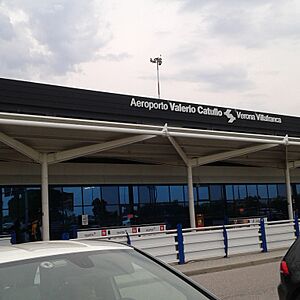Verona facts for kids
Quick facts for kids
Verona
Verona / Veròna (Venetian)
|
|||
|---|---|---|---|
| Comune di Verona | |||
|
Skyline of Verona
Palazzo Maffei
Scaliger Tombs
Window Frame of Basilica of San Zeno
Verona Cathedral
Juliet's Balcony
Verona Arena
|
|||
|
|||
| Country | Italy | ||
| Region | Veneto | ||
| Province | Verona (VR) | ||
| Frazioni | Avesa, San Michele Extra, San Massimo all'Adige, Quinzano, Quinto di Valpantena, Poiano di Valpantena, Parona di Valpolicella, Montorio Veronese, Mizzole, Marchesino, Chievo, Cà di David e Moruri | ||
| Area | |||
| • Total | 140.84 km2 (54.38 sq mi) | ||
| Elevation | 59 m (194 ft) | ||
| Population
(2022)
|
|||
| • Total | 248,030 | ||
| • Density | 1,761.08/km2 (4,561.17/sq mi) | ||
| Demonym(s) | Veronese Scaligero |
||
| Time zone | UTC+1 (CET) | ||
| • Summer (DST) | UTC+2 (CEST) | ||
| Postal code |
37100
|
||
| Dialing code | 045 | ||
| Patron saint | Saint Zeno of Verona | ||
| Saint day | 12 April | ||
| UNESCO World Heritage Site | |||
| Criteria | Cultural: ii, iv | ||
| Inscription | 2000 (24th Session) | ||
| Area | 444.4 ha | ||
| Buffer zone | 303.98 ha | ||
Verona is a beautiful city in Veneto, Italy. It sits on the River Adige. About 258,000 people live here. It is the biggest city in its region, Veneto.
Verona is a top spot for tourists in Northern Italy. People love its amazing old buildings and art. It also hosts many yearly fairs and a famous opera season at the Arena. This Arena is a very old Roman amphitheater.
From the 1200s to 1300s, the della Scala family ruled Verona. Under their leader, Cangrande I della Scala, the city became very rich and strong. Many old buildings from their time are still in Verona today.
Two of William Shakespeare's famous plays take place in Verona. These are Romeo and Juliet and The Two Gentlemen of Verona. Even though Shakespeare might not have visited, his plays made many people want to see Verona. In 2000, UNESCO named Verona a World Heritage Site. This means its city design and buildings are very special.
Verona will host the closing ceremonies for the 2026 Winter Olympics.
Contents
History of Verona
The early history of Verona is a bit of a mystery. One idea is that the Euganei people first lived here. Then, the Cenomani took over around 550 BC.
Around 300 BC, the Romans conquered the area. Verona became a Roman town in 89 BC. It was important because many roads met there. In 402 AD, a Roman general named Stilicho defeated the Visigoths here.
Later, the Ostrogoths took over in 489 AD. Their king, Theoderic the Great, is said to have built a palace in Verona. The city stayed under Gothic rule for a long time. In 569, Alboin, King of the Lombards, captured Verona. It became a very important city in his kingdom.
Under the Holy Roman Empire, Verona was sometimes called Bern in German. In 1135, Verona became a free city. In 1164, Verona joined with other cities to form the Veronese League. They fought against Frederick I Barbarossa. They won a big battle in 1176.
In 1226, Ezzelino III da Romano became the ruler. He was known for a terrible event in 1257. He caused 11,000 people from Padua to be killed on the plains of Verona. After he died, Mastino I della Scala became the ruler. He made the city his family's property.
His son, Alberto della Scala, ruled from 1277 to 1302. This was a time of many wars. Then came Cangrande I della Scala (1291–1329). He was a great fighter and a supporter of art. He helped famous writers like Dante Alighieri and Petrarch. He also took control of other cities like Treviso and Padua. Before the Black death, Verona had over 40,000 people.
Cangrande was followed by Mastino II della Scala (1329–1351). He continued to expand his family's power. He bought Parma and Lucca. He was one of the richest princes of his time. But other powerful families formed a league against him in 1337. After a three-year war, the Scaliger family lost much of their land.
Mastino's son, Cangrande II della Scala (1351–1359), was a harsh ruler. His brother, Cansignorio, killed him. Cansignorio (1359–1375) made the city more beautiful. He built palaces and bridges. He also killed his other brother. This family fighting continued.
In 1387, Antonio della Scala fled Verona. This ended the Scaliger family's rule. The city then came under the control of Milan.
In 1405, Verona became part of Venice. From 1508 to 1517, Emperor Maximilian I ruled the city. The Black Death caused many outbreaks. In 1630–1631, about 33,000 people died in Verona. This was over 60% of the population.
In 1776, a special way of bellringing called Veronese bellringing art was created here. Napoleon took over Verona in 1797. But the people fought back and drove out the French. Napoleon then ended the Venetian Republic. Verona became part of Austria in 1797. It was briefly part of Napoleon's kingdom again. But it returned to Austria in 1814.
In 1866, Verona became part of a united Italy. This happened after the Third Italian War of Independence.
During World War II, Verona became very important to the Nazis. Many people were held in an old Austrian fort. This included Allied soldiers and those who opposed the Nazis. In 1944, a famous trial took place at Castelvecchio. Galeazzo Ciano, Mussolini's son-in-law, was executed there. The city was finally freed by Allied troops in April 1945.
After World War II, Verona became important for NATO. It was close to the Iron Curtain. So, it had a strong military presence, especially American, during the Cold War.
Verona's Climate
Verona has a humid subtropical climate. This means it has hot summers and cool, wet winters. Lake Garda nearby makes the weather a bit milder. The air is often humid all year. In winter, this can cause fog, especially in the mornings. However, fog has become less common in recent years.
| Climate data for Verona (Villafranca Airport) (1991–2020 normals, extremes 1946–present) | |||||||||||||
|---|---|---|---|---|---|---|---|---|---|---|---|---|---|
| Month | Jan | Feb | Mar | Apr | May | Jun | Jul | Aug | Sep | Oct | Nov | Dec | Year |
| Record high °C (°F) | 19.8 (67.6) |
22.1 (71.8) |
27.2 (81.0) |
31.8 (89.2) |
36.6 (97.9) |
38.1 (100.6) |
38.2 (100.8) |
39.0 (102.2) |
33.2 (91.8) |
29.2 (84.6) |
23.6 (74.5) |
18.8 (65.8) |
39.0 (102.2) |
| Mean daily maximum °C (°F) | 7.3 (45.1) |
10.0 (50.0) |
14.9 (58.8) |
19.1 (66.4) |
24.1 (75.4) |
28.2 (82.8) |
30.4 (86.7) |
30.4 (86.7) |
25.4 (77.7) |
19.1 (66.4) |
12.6 (54.7) |
7.8 (46.0) |
19.1 (66.4) |
| Daily mean °C (°F) | 2.9 (37.2) |
4.5 (40.1) |
9.1 (48.4) |
13.2 (55.8) |
18.4 (65.1) |
22.7 (72.9) |
24.9 (76.8) |
24.6 (76.3) |
19.6 (67.3) |
13.9 (57.0) |
8.4 (47.1) |
3.6 (38.5) |
13.8 (56.9) |
| Mean daily minimum °C (°F) | −0.5 (31.1) |
0.1 (32.2) |
3.9 (39.0) |
7.6 (45.7) |
12.5 (54.5) |
16.9 (62.4) |
18.9 (66.0) |
18.7 (65.7) |
14.2 (57.6) |
9.5 (49.1) |
4.8 (40.6) |
0.2 (32.4) |
8.9 (48.0) |
| Record low °C (°F) | −18.4 (−1.1) |
−18.4 (−1.1) |
−10.4 (13.3) |
−2.2 (28.0) |
0.0 (32.0) |
3.8 (38.8) |
7.3 (45.1) |
8.1 (46.6) |
2.0 (35.6) |
−4.6 (23.7) |
−7.9 (17.8) |
−15.5 (4.1) |
−18.4 (−1.1) |
| Average precipitation mm (inches) | 42.7 (1.68) |
45.4 (1.79) |
45.1 (1.78) |
72.3 (2.85) |
81.9 (3.22) |
72.2 (2.84) |
62.9 (2.48) |
71.8 (2.83) |
90.9 (3.58) |
85.8 (3.38) |
95.9 (3.78) |
64.6 (2.54) |
831.7 (32.74) |
| Average precipitation days (≥ 1.0 mm) | 5.9 | 5.5 | 5.6 | 8.7 | 8.4 | 8.4 | 5.2 | 5.9 | 6.7 | 7.7 | 8.7 | 7.2 | 82.0 |
| Average relative humidity (%) | 82.1 | 75.3 | 71.8 | 71.1 | 70.2 | 70.1 | 70.1 | 71.6 | 73.5 | 79.3 | 83.1 | 82.7 | 77 |
| Average dew point °C (°F) | 0.49 (32.88) |
0.61 (33.10) |
3.93 (39.07) |
7.59 (45.66) |
12.05 (53.69) |
16.12 (61.02) |
18.18 (64.72) |
18.57 (65.43) |
14.60 (58.28) |
10.85 (51.53) |
6.22 (43.20) |
1.38 (34.48) |
9.22 (48.59) |
| Mean monthly sunshine hours | 91.3 | 131.1 | 181.5 | 184.1 | 237.7 | 259.5 | 307.6 | 278.8 | 203.6 | 129.4 | 85.4 | 87.4 | 2,177.4 |
| Source 1: Istituto Superiore per la Protezione e la Ricerca Ambientale(Monthly max-Precipitation and days) | |||||||||||||
| Source 2: NOAA (daily mean-monthly min-humidity-dew point)(Sun 1981-2010), Servizio Meteorologico(Extremes) | |||||||||||||
People of Verona
| Country of birth | Population |
|---|---|
| 12,520 | |
| 7,234 | |
| 5,008 | |
| 3,233 | |
| 2,857 | |
| 2,500 | |
| 1,975 | |
| 1,444 |
In 2009, about 265,000 people lived in Verona. About 47.6% were male and 52.4% were female. Children (0–17 years old) made up about 16% of the population. Older people (pensioners) were about 22.36%. The average age of people in Verona is 43.
Between 2002 and 2007, Verona's population grew by 3.05%. Most people in Verona (87%) are Italian. The largest groups of immigrants come from other European countries, like Romania. There are also people from South Asia and Sub-Saharan Africa. Most people in Verona are Roman Catholic. But due to immigration, there are also Orthodox Christian and Muslim people.
Main Sights and Landmarks
Verona is a UNESCO World Heritage Site. This is because of its many important historical buildings. Verona kept many ancient Roman buildings. But a big earthquake in 1117 damaged many medieval ones. This led to a lot of rebuilding in the Romanesque style.
Roman Buildings
The old Roman city was built with straight roads that crossed each other. This plan is still visible today. Most of the Roman city is about 6 meters (20 feet) below the ground. Many buildings have cellars built on top of these old Roman structures.
Verona is famous for its Roman amphitheater, the Arena. It is in the city's biggest square, Piazza Bra. It was finished around 30 AD. It is the third largest in Italy. It could hold about 25,000 people. Shows and gladiator games were held here. They were so famous that people came from far away to watch. Today, the Arena is still used for concerts and opera shows in summer.
Piazza delle Erbe is near the old Roman forum. It was rebuilt using materials from Roman buildings.
Verona has other Roman monuments too. The Roman theatre of Verona was built in the 1st century BC. Over time, houses were built on top of it. In the 1700s, a rich man bought and removed these houses to save the theater. Near it is the Ponte di Pietra ("Stone Bridge"). This is another Roman landmark that is still standing.
The Arco dei Gavi was built in the 1st century AD. It is special because it has the builder's name carved on it. This was rare back then. It was taken down in 1805 and rebuilt in 1932.
Nearby is the Porta Borsari. This is an archway that was once part of the Roman city walls. The writing on it is from 245 AD. It calls the city Colonia Verona Augusta. The road through the gate is the original main Roman street. Today, it has many Renaissance buildings.
Porta Leoni is another Roman gate ruin from the 1st century BC. A large part of it is still standing. The street here is an archaeological site. You can see parts of the old Roman street and gate foundations below the current street.
The Santo Stefano church is very old. It was built in the early Christian era. It holds the tombs of Verona's first bishops. It has a rare two-story walkway. This was probably for pilgrims to see the many important holy items kept there.
Medieval Buildings
The Basilica of San Zeno Maggiore is a beautiful Romanesque church. It was built from 1123 to 1135. It stands over a 4th-century shrine to Verona's patron saint, St. Zeno. The church has a tall, 72-meter bell tower. The famous writer Dante Alighieri mentioned it. The church has a large rose window shaped like a Wheel of Fortune. The doors have carvings of Bible scenes. Inside, the church has two levels. The walls are covered with old paintings from the 1100s and 1300s. The crypt holds the tomb of St. Zeno.
Piazza dei Signori is a lovely medieval square. It has many old buildings and towers. There is a statue dedicated to Dante Alighieri here.
The Basilica of San Lorenzo is another Romanesque church. It was built around 1177. It has two round towers with spiral stairs. The inside is simple but peaceful.
Santa Maria Antica is a small Romanesque church. It was the private chapel for the Scaligeri family. It is known for the Gothic Scaliger Tombs.
The Verona Cathedral, also called the Duomo, is another important Romanesque church.
Sant'Anastasia is a very large church. It was built from 1290 to 1481 by the Dominicans. Its size was needed for the many people who came to hear their sermons. It has a famous painting by Pisanello.
The Castelvecchio Bridge, also called Ponte Scaligero, is an old arch bridge. When it was finished in 1356, it had the world's largest bridge arch.
Sports in Verona
Verona has two professional football (soccer) teams. The main team is Hellas Verona. They won the Italian Serie A championship in 1985. They played in the European Cup the next year. Chievo Verona was another team from a Verona suburb. They stopped playing in 2021. Hellas Verona plays in Serie A, the top Italian league. Virtus Verona, another city club, plays in Serie C. Both Hellas and Chievo used to share the Stadio Marcantonio Bentegodi. This stadium was used for the 1990 FIFA World Cup.
Verona also has a volleyball team, Verona Volley. There is a rugby team, Franklin and Marshall Cus Verona Rugby. The basketball team is Scaligera Basket.
The city has hosted the UCI Road World Championships for cycling twice. It also often hosts stages of the Giro d'Italia cycling race. Verona hosted the baseball world cup in 2009. It also hosted the Volleyball World Cup in 2010 and the Volleyball Women's World Championship in 2014.
Travel and Transport
Public Transportation
Public transport in Verona is run by Azienda Trasporti Verona (ATV). From 1884 to 1951, Verona had a tram network. Trolleybuses replaced the trams. Then, buses replaced the trolleybuses in 1975. A new trolleybus system is now being built. It is expected to open in 2026.
A special lift, the Verona funicular, opened in 2017. It helps people get from the Ponte Pietra to the Roman theatre museum and San Pietro Castle.
Train Travel
Verona is a major train hub. It is where the north-south line from the Brenner Pass to Rome crosses the east-west line between Milan and Venice. This connects Verona to most of Europe by train. You can take direct international trains to Zurich, Innsbruck, and Munich. There are also overnight sleeper trains.
Verona's main train station is Verona Porta Nuova railway station. It is south of the city center. It is one of Italy's busiest stations. About 68,000 passengers use it every day.
There is a smaller station to the east, Porta Vescovo. This used to be the main station. Now, it mainly handles trains between Venice and Porta Nuova.
Airport Travel
Verona Airport is about 10 kilometers (6 miles) southwest of Verona. It serves around 3 million passengers each year. A regular bus service connects the airport to Porta Nuova train station.
You can fly directly from Verona to many cities. These include Rome, Munich, Berlin, Moscow, Naples, Frankfurt, and London.
Famous People from Verona
Many notable people were born in Verona or lived there:
- Paolo Caliari (1528–1588), a famous painter known as "Veronese"
- Catullus (c. 84-c. 54 BCE), an important Latin poet
- Mario Capecchi (born 1937), who won the Nobel Prize in Medicine in 2007
- Gigliola Cinquetti (born 1947), a singer who won the Eurovision Song Contest for Italy in 1964
- Damiano Cunego, a former top cyclist and winner of the Giro d'Italia race
- Girolamo Fracastoro, a well-known scholar, doctor, and poet
- Romeo Montague and Juliet Capulet, the fictional characters from Shakespeare's play Romeo and Juliet
- Antonio Salieri (1750–1825), a famous composer
- Emilio Salgari (1862–1911), a novelist
- Sara Simeoni, a former world record holder and Olympic gold medalist in high jump
- Achille Lauro, a singer and rapper
Verona's International Connections
Sister Cities
Verona is connected with these cities around the world:
 Albany, United States
Albany, United States Johannesburg, South Africa
Johannesburg, South Africa Munich, Germany
Munich, Germany Nagahama, Japan
Nagahama, Japan Nîmes, France
Nîmes, France Pula, Croatia
Pula, Croatia Saint-Josse-ten-Noode, Belgium
Saint-Josse-ten-Noode, Belgium Salzburg, Austria
Salzburg, Austria
Friendship Pacts
Verona also has friendly relations with these cities:
See also
 In Spanish: Verona para niños
In Spanish: Verona para niños


